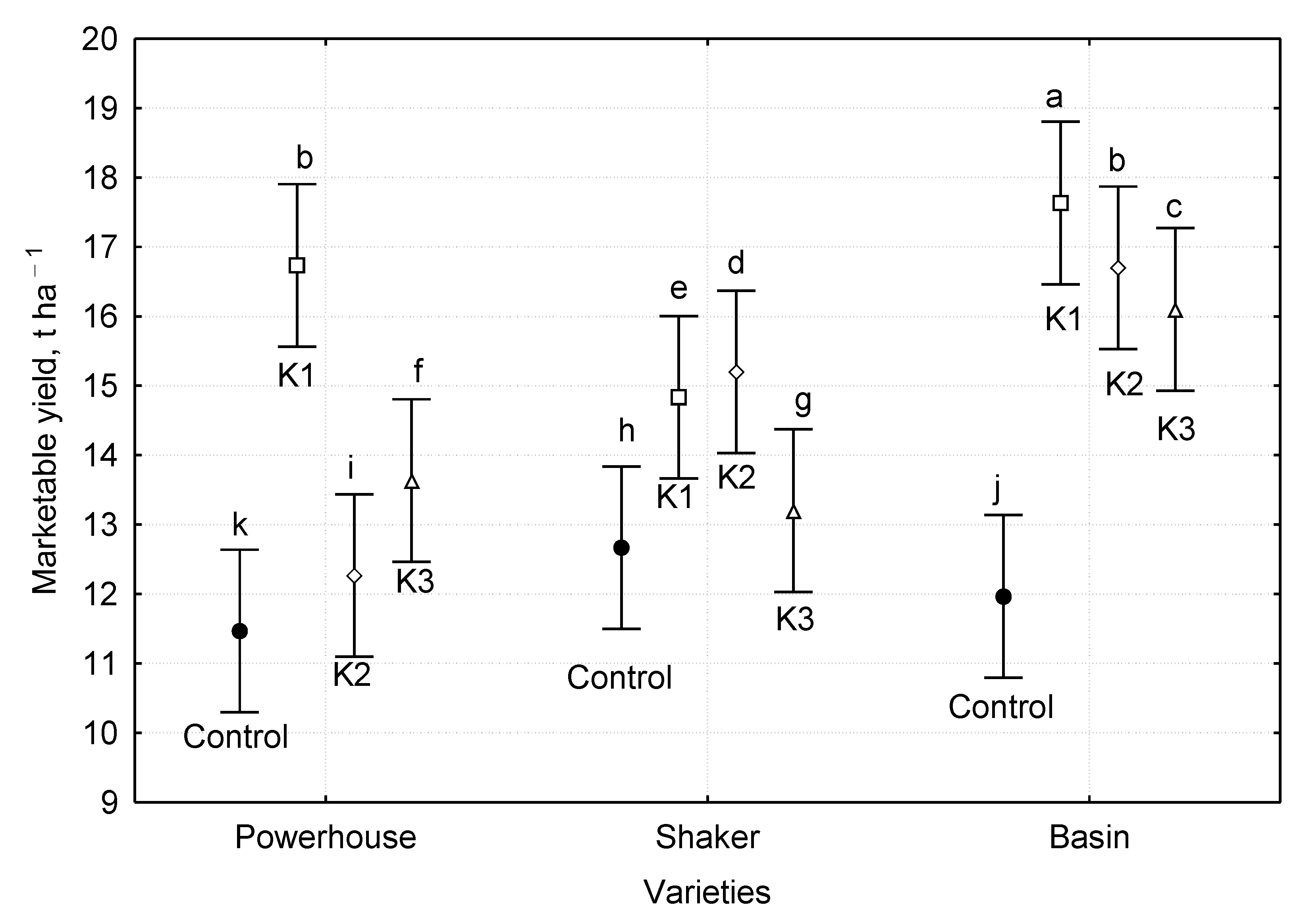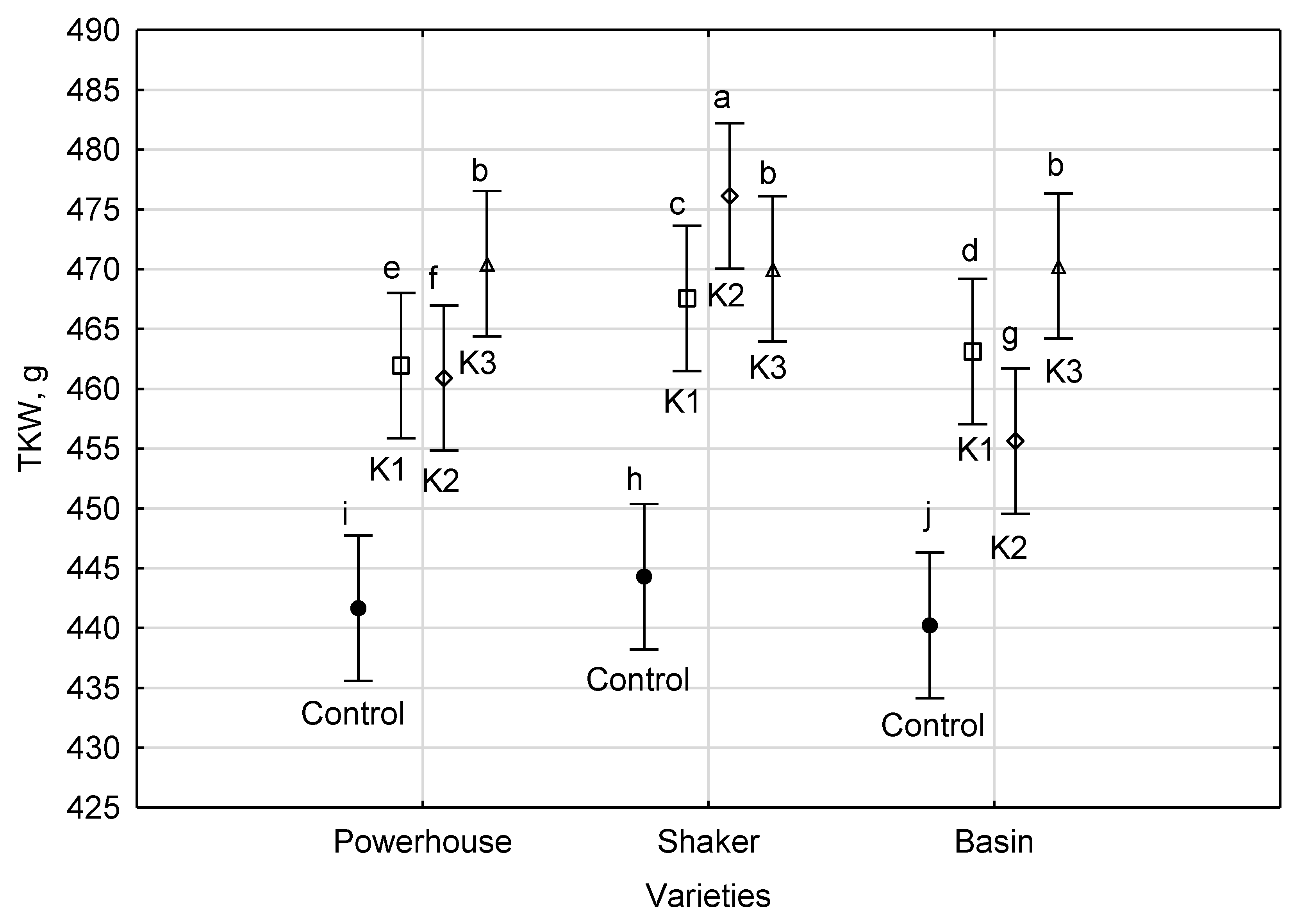Impact of Pre-Sowing Red Light Treatment of Sweet Corn Seeds on the Quality and Quantity of Yield
Abstract
:1. Introduction
2. Material and Methods
2.1. Plant Material
2.2. Light Treatment Method
2.3. Field Experiment and Date Collections
2.4. Statistical Analysis
3. Results
3.1. Yield and Corn Cobs Quality
3.2. Corn Cobs’ Length
3.3. Thousand Kernel Weight
4. Discussion
4.1. Yield and Cobs Quality
4.2. Length of Corn Cobs
4.3. Thousand Kernel Weight (TKW)
5. Conclusions
Author Contributions
Funding
Conflicts of Interest
References
- Gao, C.; El-Sawah, A.M.; Ali, D.F.I.; Hamoud, Y.A.; Shaghaleh, H.; Sheteiwy, M.S. The integration of bio and organic fertilizers improve plant growth, grain yield, quality and metabolism of hybrid maize (Zea mays L.). Agronomy 2020, 10, 319. [Google Scholar] [CrossRef] [Green Version]
- Rosa, R. Quality of sweet corn yield depending on winter catch crops and weed control method. Acta Sci. Pol. Hortorum Cultus 2015, 14, 59–74. [Google Scholar]
- Datta, D.; Chandra, S.; Singh, G. Yield and quality of sweet corn under varying irrigation regimes, sowing methods and moisture conservation practices. J. Pharmacogn. Phytochem. 2019, 8, 1185–1188. [Google Scholar]
- Williams, M.M. Biological significance of low weed population densities on sweet corn. Agron. J. 2010, 102, 464–468. [Google Scholar] [CrossRef]
- Krawiec, M.; Dziwulska-Hunek, A.; Kornarzyński, K. The use of physical factors for seed quality improvement of horticultural plants. J. Hort. Res. 2018, 26, 81–94. [Google Scholar] [CrossRef] [Green Version]
- Siyami, R.; Mirshekari, B.; Farahvash, F.; Rashidi, V.; Tarinejad, A. The effect of physical priming of seed on traits and yield of corn (Zea Mays L.) under water deficit conditions in Iran. Appl. Ecol. Environ. Res. 2018, 16, 617–627. [Google Scholar] [CrossRef]
- Hanafy, M.S.; Husein, G.; Abdelmoty, E. Effect of 50 Hz 6 kV/m electric field on the protein molecular structureand the growth characteristics of the broad bean. Phys. Alive 2005, 13, 41–54. [Google Scholar]
- Pietruszewski, S.; Muszynski, S.; Dziwulska, A. Electromagnetic fields and electromagnetic radiation as non-invasive external stimulants for seeds (selected methods and responses). Int. Agrophys. 2007, 21, 95–101. [Google Scholar]
- Dziwulska-Hunek, A.; Kornarzyński, K.; Matwijczuk, A.; Pietruszewski, S.; Szot, B. Effect of laser and variable magnetic field simulation on amaranth seeds germination. Int. Agrophys. 2009, 23, 229–235. [Google Scholar]
- Hernández, A.C.; Carballo, C.A.; Artola, A.; Michtchenko, A. Laser irradiation effects on maize seed field performance. Seed Sci. Technol. 2006, 34, 193–197. [Google Scholar] [CrossRef]
- Hernández, A.C.; Dominguez, P.A.; Cruz, O.A.; Ivanov, R.; Carballo, C.A.; Zepeda, B.R. Laser in agriculture. Int. Agrophys. 2010, 24, 407–422. [Google Scholar]
- Isaac, A.E.; Hernández, A.C.; Domínguez, P.A.; Cruz, O.A. Effect of pre-sowing electromagnetic treatment on seed germination and seedling growth in maize (Zea mays L.). Agron. Colomb. 2011, 29, 213–220. [Google Scholar]
- Matwijczuk, A.; Kornarzyński, K.; Pietruszewski, S. Effect of magnetic field on seed germination and seedling growth of sunflower. Int. Agrophys. 2012, 26, 271–278. [Google Scholar] [CrossRef]
- Pietruszewski, S.; Martinez, E. Magnetic field as a method of improving the quality of sowing material: A review. Int. Agrophys. 2015, 29, 377–389. [Google Scholar] [CrossRef]
- Govindaraj, M.; Masilamani, P.; Alex Albert, V.; Bhaskaran, M. Effect of physical seed treatment on yiled and quality of crops: A review. Agric. Rev. 2017, 38, 1–14. [Google Scholar]
- Hasan, M.; Hanafiah, M.M.; Taha, Z.A.; AlHilfy, I.H.H.; Said, M.N.M. Laser irradiation effects at different wavelengths on phenology and yield components of pretreated maize seed. Appl. Sci. 2020, 10, 1189. [Google Scholar] [CrossRef] [Green Version]
- Gładyszewska, B. Estimation of laser biostimulation dose. Int. Agrophys. 2011, 25, 403–405. [Google Scholar]
- Khan, A.; Khalili, S.K.; Khan, A.Z.; Marwat, K.B.; Afzal, A. The role of seed priming in semi- arid area for mung beam phenology and yield. Pak. J. Bot. 2008, 40, 2471–2480. [Google Scholar]
- Gao, J.; Shi, J.; Dong, S.; Liu, P.; Zhao, B.; Zhang, J. Grain yield and rot characteristics of summer maize (Zea mays L.) under shade stress conditions. J. Agron. Crop. Sci. 2017, 203, 562–573. [Google Scholar] [CrossRef]
- Zarębski, Z.W.; Dziamba, S. Sposób przedsiewnej obróbki ziarna i urządzenie do przedsiewnej obróbki ziarna (In Polish). Urząd Patentowy Rzeczypospolitej Polskiej. Patent 170929 28 February 1997. [Google Scholar]
- PN-R-75377:1996. Kukurydza cukrowa (In Polish). Polska Norma. Available online: https://sklep.pkn.pl/pn-r-75377-1996p.html (accessed on 30 April 2020).
- Yang, Y.; Xu, W.; Hou, P.; Liu, G.; Liu, W.; Wang, Y.; Zhao, R.; Ming, B.; Xie, R.; Wang, K.; et al. Improving maize grain yield by matching maize growth and solar radiation. Sci. Rep. 2019, 9, 3635. [Google Scholar] [CrossRef] [Green Version]
- Gao, J.; Zhao, B.; Dong, S.; Liu, P.; Ren, B.; Zhang, J. Response of summer maize photosynthate accumulation and distribution to shading stress assessed by using 13CO2 stable isotope tracer in the field. Front. Plant Sci. 2017, 8, 1821. [Google Scholar] [CrossRef] [Green Version]
- Yang, H.; Shi, Y.; Xu, R.; Lu, D.; Lu, W. Effects of shading after pollination on kernel filling and physicochemical quality traits of waxy maize. Crop J. 2016, 4, 235–245. [Google Scholar] [CrossRef] [Green Version]
- Jia, S.; Li, C.; Dong, S.; Zhang, J. Effects of shading at different stages after anthesis on maize grain weight and quality at cytology level. Agric. Sci. China 2011, 10, 58–69. [Google Scholar] [CrossRef]
- Dziamba, S.; Dziamba, M.; Machaj, H.; Klimek, A. The influence of pre-sowing stimulation of seeds with light on yielding of some maize varieties. Biul. Inst. Hod. Aklim. Roślin 2004, 231, 445–451. (In Polish) [Google Scholar]
- Makarska, E.; Michalak, M.; Wesołowska-Trojanowska, M. Wpływ światła lasera na wartość siewną oraz poziom antyoksydantów wybranych odmian pszenicy ozimej. Acta Agrophys. 2004, 4, 407–417. (In Polish) [Google Scholar]
- Wesołowski, M.; Cierpiała, R. Przedsiewne naświetlanie laserem nasion pszenicy ozimej a jej plonowanie. Acta Agrophys. 2006, 8, 1031–1040. (In Polish) [Google Scholar]
- Abbas, H.; Ranjan, R.S. Effect of overhead irrigation on corn yield and quality under shallow water table conditions. Can. Biosyst. Eng. 2016, 58, 33–44. [Google Scholar] [CrossRef]
- Brum, M.D.S.; Cunha, V.D.S.; Stecca, J.D.L.; Grando, L.F.T.; Martin, T.N. Compoents of corn crop yiels under inoculation with Azospirllum brasilense using integrated crop-livestock system. Acta Sci. Agron. 2016, 38, 485–492. [Google Scholar] [CrossRef] [Green Version]
- Hernández, A.C.; Rodríguez, P.C.L.; Domínguez-Pacheco, F.A.; Hernández, A.A.M.; Cruz-Orea, A.; Carballo, C.A. Laser light on the mycoflora content in maize seeds. Afr. J. Biotechnol. 2011, 10, 9280–9288. [Google Scholar] [CrossRef] [Green Version]
- Ramachandrappa, B.K.; Nanjappa, H.V.; Shivakumar, H.K. Yield and quality of baby corn (Zea Mays L.) as influenced by spacing and fertilization levels. Acta Agron. Hung. 2004, 52, 237–243. [Google Scholar] [CrossRef] [Green Version]
- Prisecaru, G.; Sala, F. Response model of vegetation parameters and yield in maize under the influence of Lithovit fertilizer. AIP Conf. Proc. 2017, 1863, 430005. [Google Scholar] [CrossRef]
- Bâşa, A.G.; Ion, V.; Dumbravă, M.; Temocico, G.; Epure, L.I.; Dumitru, S. Grain yield and yield components at maize under different preceding crops and nitrogen fertilization conditions. Agric. Agric. Sci. Proc. 2016, 10, 104–111. [Google Scholar] [CrossRef] [Green Version]
- Karthik, S.K.; Mahesh, T.; Sumanth, B.; Tanmay, M. Study of physical and engineering properties of corn (Zea mays). Bull. Env. Pharmacol. Life Sci. 2017, 6, 404–409. [Google Scholar]
- Makarska, E. Wpływ światła lasera na wskaźniki jakości technologicznej dwóch odmian pszenicy ozimej. Acta Agrophys. 2009, 14, 137–144. (In Polish) [Google Scholar]





© 2020 by the authors. Licensee MDPI, Basel, Switzerland. This article is an open access article distributed under the terms and conditions of the Creative Commons Attribution (CC BY) license (http://creativecommons.org/licenses/by/4.0/).
Share and Cite
Dziwulska-Hunek, A.; Szymanek, M.; Stadnik, J. Impact of Pre-Sowing Red Light Treatment of Sweet Corn Seeds on the Quality and Quantity of Yield. Agriculture 2020, 10, 165. https://doi.org/10.3390/agriculture10050165
Dziwulska-Hunek A, Szymanek M, Stadnik J. Impact of Pre-Sowing Red Light Treatment of Sweet Corn Seeds on the Quality and Quantity of Yield. Agriculture. 2020; 10(5):165. https://doi.org/10.3390/agriculture10050165
Chicago/Turabian StyleDziwulska-Hunek, Agata, Mariusz Szymanek, and Joanna Stadnik. 2020. "Impact of Pre-Sowing Red Light Treatment of Sweet Corn Seeds on the Quality and Quantity of Yield" Agriculture 10, no. 5: 165. https://doi.org/10.3390/agriculture10050165




